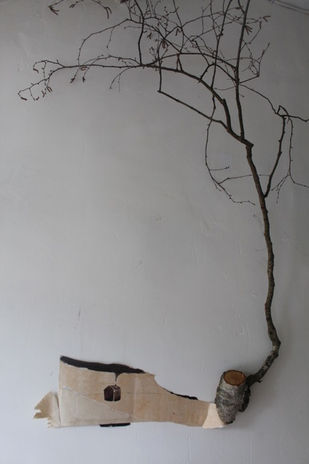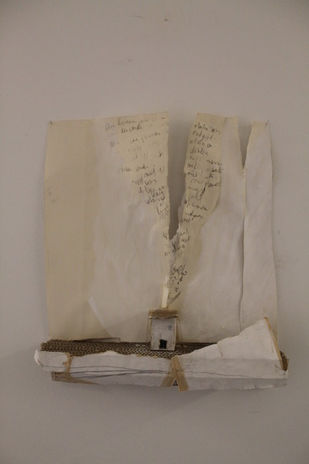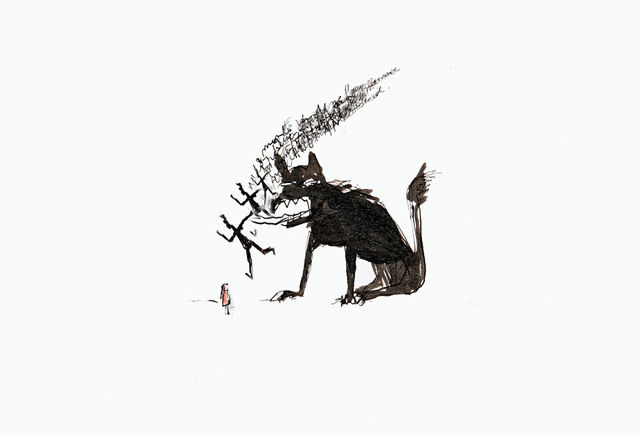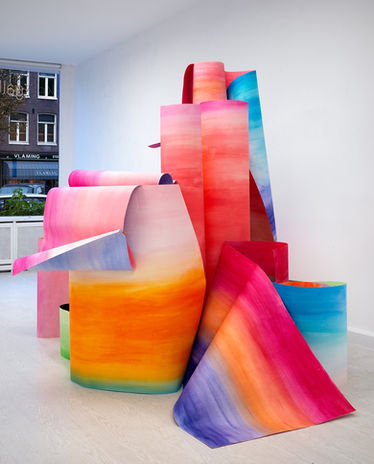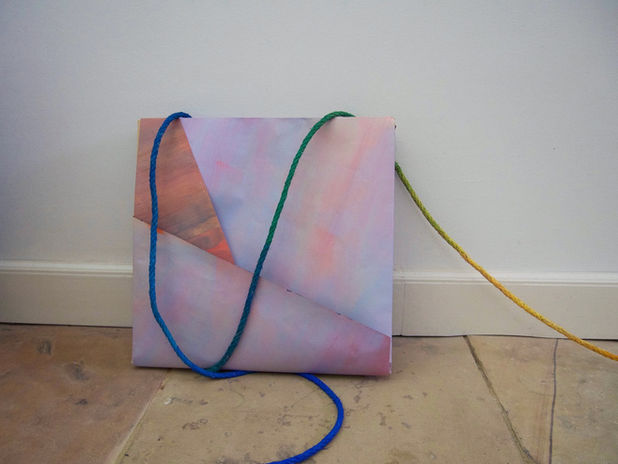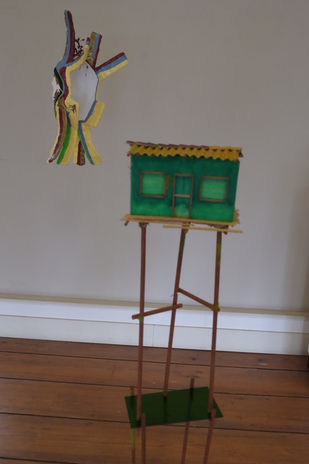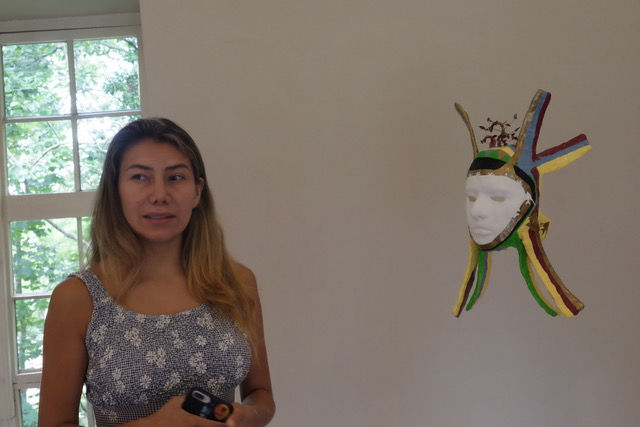

























The title of the exhibition is "Until the Wolf is There", named after a children's song of the same name. The song goes "Let's play in the forest until the wolf is there, is the wolf there?" And then the wolf answers what activity he performs to start his day. While the wolf prepares himself, the children play. The wolf gets up, brushes his teeth, bathes and dresses, until he is ready to hunt. Then the wolf answers the children that he is already there and that he will eat them. He then continues to hunt them and the children start to run.
UNTIL THE WOLF IS THERE shows a duality: a bizarreity. The works look beautiful, but delve on more complex underlying themes that are the result of social or personal problems. Both the positive (the forest, the jungle, the infant, the family, the celebration of life) and the negative (the wolf, the predator, fear, lack of resources, conflict) take part in this play.
"Not all that shines is gold",
Popular saying.
Some of the topics dealt with are: deprivation, migration, war and depletion of natural resources, but also mental states: depression, anxiety, loneliness, vulnerability and difficulties to feel, amongst others. However, the exhibition shows as well how in complex contexts there are individuals or prosesses able to counteract or stand. Despite feelings that could catalogue someone as weak, fragile or sad amongst others, a person can be beautiful in its fragility, very strong by living with it and very lovely -to have empathy- towards others. Despite the violence, subjects can show admirable strength in the shape of love and community. Despite continuous acts against nature, it can show also its strength and the possibility to overcome.
Finally, it must be said that the beauty of the works give them a fairytale notion -that might feel also as awkward beauty- and this fits well with the location of the castle.
-PARCE
Landgoed De Campagne is a Ghent nature reserve and park. It includes various biotopes such as a pond, grasslands, forest areas and canals and it therefore has a very diverse fauna and flora. The villa used to belong to a bigger castle, inhabited by the Hamelinck family in the 18th century. They later left the place because a family member, Louis Hamelinck was murdered there. After that it has been property of the Jesuit order. In 1972 it became property of the City of Ghent. The garden was opened to the public and the castle was designated as a cultural center. In my opinion, this is a good location in relation to the theme of the exhibition.
Address: Gijzelstraat 12, 9031 Ghent
Size: 277m2 (divided over two exhibition rooms)
ARTISTS
PROGRAM
PROGRAM
Gentse Feesten Special: Cocktail/BBQ-night in the forest:
20 July, 5-8 p.m.
Carolina Rodríguez
(COL)
"Dónde están los niños" (Where are the children?) is a retrospective exhibition of the artist, who for more than 15 years has been reflecting on the position of children in our society and how in some cases the media transforms our way of seeing and relating to them. Carolina uses colored pencils and other materials that bring us closer to the world of children, however the sight she produces is critical and provokes in the viewer reflection about childhood in the contemporary world.

Peter Land (DK)
PETER LAND is one of the leading contemporary artists of Denmark. He makes performances, paintings, drawings, videos, sculptures with the same trademark, his tragicomedical flair.
Man's ambitions and failures in his difficulty finding balance and meaning are the recurring source for absurd situations and compositions. At the same time obscure and funny, hopeless and light, Land never shuns the extreme, and we are confronted with our own "all too humanity", reminding us of how much we are concerned with our identity and how it may be determined by the failure instead of becoming our 'self'.
The subconscious and self are explored by blurring the boundaries between memories and expression, through children's games and nightmares, despair and the idyllic ... The surreal and the grotesque ignite an existential alienation and we remain restless but amused.
Land's work has been shown at numerous exhibitions in Europe, North America, Asia and Australia, including solo shows at Galleri Nicolai Wallner, Copenhagen, Denmark; the New Museum, New York, NY; and the Mori Art Museum, Tokyo, Japan. Land represented Denmark at the Venice Biennale in 2005.
References:
-Galleri Nicolai Wallner, "Peter Land - Showbizz (2015)"
-E. Emmert et. al, "Peter Land: Absolute Perfection" Berlin: Hatje Cantz 2013.
Marina Lauwers (BE)
Fairy tales are the basis of Marina's work. These stories deal with very current topics such as poverty, migration, war, cruelty, love and a search for happiness and a better life. Her works are also references to mental states: depression, anxiety, loneliness, for example, arising from social problems (such as forced migration, violence) and personal problems (vulnerability, difficulties to feel).
Marina: "Time stands still, the wolf looks. The house keeps on balancing but does not fall. We wait ... until the wolf attacks and Little Red Riding Hood runs away or the house falls off the cliff."
Luis Hernández Mellizo (COL)
Luis Hernández Mellizo's work is fundamentally visual and is adjusted according to each new project; his works feed on local contexts put into consideration with others, the resignification of social discourses and conventions on the artistic. Luis investigates cultural identities and social discourses in different places, aimed at making connections between his work and a working class.
The work of Mellizo is moulded around experiences and understandings of different cultures. He examines, researches and compiles information, whilst reflecting on his own situation as an artist in society. The artist’s projects tend to be characterized through the use of simple materials, such as books, newspapers, souvenirs and other mundane objects, in order to explore the meanings around cultures, societies, languages and arts.
Barbara Rink (NL)
In her installation work Barbara uses the basic elements of painting as sculptural components. She dissects painting into enlarged cut out shapes, gradients, lines, shadow and light. These come together in fragile looking structures, mirroring constructions of the mind. By suggesting different moments in time happening at the same instant like falling apart and being under construction, she investigates organic and cyclical processes while adding a performative quality to the fixed works. Engaging with a perspective of magical thinking she considers the possibilities of painting and color as means of exploring three dimensional space.
Maite Ibarreche (COL)
Maite's work is related to the way we humans treat our natural resources. The work is changing: it shows the process of exhaustion. In her piece, only the first layer was colored, by draining it in ink. This layer supplies all subsequent layers with ink, until there is no more ink to be substracted. The first layer is therefore full and the last layer almost empty. Maite’s work speaks about how we work with the world, how our exploitation of the world is unsustainable. She tries to evoke universal ideas through the visual language of matter itself. Here the imaginary and the physical, the surplus and the void, the accumulation and the residue and the alignment of different moments of a process come together. The artist believes that it is possible to recognize in these dualities, as well as in the light clues written in matter by the processes themselves, the dynamics that we humans exert with our material and symbolic resources.
Doina Kraal (NL)
Doina: A small statuette - a figure with a lumpy back, or a rucksack and a large head - looks friendly from the outside. A second sculpture is rather amorphous; it is covered in what looks like dark red mud with a rough texture. The top half is shaped in two blunt points and four stalks peek out at the bottom. These sculptures were not made as art works, but as fetish images or objects used in rituals in Togo, Africa. They were made according to a set recipe. The current owner, artist George Degenhart, started collecting these statuettes not because of the story they tell, but rather because they can be understood by large groups of people, when placed in the right context. The idea of a universal understanding also runs through his oeuvre of abstract works. To Degenhart the individual history of these objects isn’t all that interesting. Contrary to Degenhart, I do feel the urge to examine the stories and histories of these objects, the secrets they may hold. Fetish statuettes are often filled with a magical, vegetal or herbal substance or with (precious) metals. I investigated a selection of fetish statuettes, amongst others by making X-ray photographs of them as can be seen in this work.
The duality addressed in this exhibition concerns the celebration of life versus the destruction of it. I strongly identify with the ever curious, playing child, but I know that the predator cannot be avoided and also lives inside of me. We exist out of contrasting elements, we have a right and a left hemisphere, which ideally collaborate and complement each other. The opposites we find around us, I don’t believe to be self-contained; they will always search or reach out for the counter side. Rebis is the unity of male and female (it derives from the latin res bina, meaning double matter). It is the result of alchemic purification, the process of separating opposing qualities. Those qualities are brought together as a hermaphrodite in a single body. As the friendly Windzanger (the statuette with the rucksack) is X-rayed, he appears to have been brutally perforated by large nails. Also his tummy is filled with shells and metal. As much as I respect these wondrous sculptures, I cannot deny that making X-rays of them is a somewhat violent act, an invasive way to investigate the secrets they behold.
Marcela Varela (COL)
When we are children, hiding is a fundamental part of our game, fantasizing and living a firm reality that we wish we won’t forget. We treasure it and guard it jealously from the views of others, the adults. During the game, scenarios, characters and stories come to life spontaneously. The characters and scenarios that appear on the canvas, are part of the fantasy and a parallel world that exists in the mind of the artist: a forest in which the magical and the somber coexist. The semitransparent fabric, like a memory, allows us to see, however it is confusing to observe what happens beyond, as well as to know what happens while others hide. Fantasy and reality are intertwined in a scenario that mysteriously hides the intentions with which it was created. Here, between the thickness of the thin fabric, the artist proposes an excellent place to hide prey from the looks, while the spectator assumes the role of hunter.
Carlos Santos, Victoria Santos, Cristóbal Santos, Nathalia Azuero (COL)
Objects – and especially furniture -, are intrinsically linked in an ethnographic way to the use given to them to the society to which they belong.
Taking as reference the ideal of the Bauhaus to create “modern solutions” for the modern home, how could furniture – no matter how modern it is – fit into a home ideal that increasingly deals with constant movements, renewal, migration and nomadism?
In this family action, we intend to reflect on the lifetime of things and how a new economy arises based on the use of resources that are considered as ruins of modernity.
Laura Vargas (COL)
Laura Vargas shows a series of animals in risk of extinction, aiming at causing the viewer to reflect when confronting the issue of the cruel disappearance and hunting of these species in a "childish and pedagogical" context where it is not apparent to present such a crude language.
Laura Peña (COL)
Laura Peña's work shows the struggle of those who are forced to live in the shadow of violence. However, her works also celebrate that victims of a conflict can eventually have their voices heard. It revolves around the coastal region of El Choco, one of the more deprived regions in Colombia, which is also heavily controlled by drug mafia and drug trafficking violence. For that reason, people cannot leave their homes here most of the day.
Laura's works make reference to a group of boys called "the Matachines." The group got that nickname because they made masks for themselves and the community, which were used in holiday celebrations and celebrative dances. This way, they brought joy to the community.The Matachines were invited to come and play a football match in another village, where prizes could be won. The boys never returned and were found by their mothers the next day: chopped and with traces of torture.
This practice is used by paramilitary groups to control the territory with fear and violence. The practice takes place in the some of the many "palafito" houses, typical for the region. These are wooden houses built on stilts in the water. The community has been buiding these for centuries as they are most resistant against the water, don't harm the nature and are very convenient for those living of fishery. They also protect against predators, hostiles and exhalations of the soil.
The mothers of the boys (and mothers in the region in general) have since then been protesting by performing a masked dance with strong movements, which are a protest against those who force them to live in the shadow of violence, while at the same time guarenteeing that they cannot easily be recognized / caught. However, the dance also celebrates that victims of a conflict eventually become strong again. A protest of happiness arose from pain.
CREDITS
Artists:
CAROLINA RODRĺGUEZ (COL)
SOLO EXHIBITION: “DONDE ESTAN LOS NIÑOS”
PETER LAND (DK)
BARBARA RINK (NL)
MARINA LAUWERS (BE)
DOINA KRAAL (NL)
MAITE IBARRECHE (COL)
LUIS HERNÁNDEZ (COL)
MARCELA VARELA (COL)
CARLOS SANTOS, VICTORIA SANTOS, CRISTÓBAL SANTOS, NATHALIA AZUERO (COL)
LAURA PEÑA (COL)
LAURA VARGAS (COL)
Introductory text for the exhibition: PARCE
Introductory texts for the pieces: PARCE Director and Artists
Text "Notes on Drawing": JAIME CERON (COL)
Art work selection/project direction by: LAURA PEÑA MURCIA (Director of PARCE)
Organizer: PARCE ART INITIATIVE
https://www.instagram.com/parce.iniciative/
Project direction and art works selection by
LAURA PEÑA
PARCE DIRECTOR
The exhibition is based on the connections of people from different places. The project is organized on the basis of collaboration, from our own funds (by way of self-management) and the funds of the artists. We are trying to collect some recourses in order to assist some artists with covering part of their travel and transportation costs. If you want to support us, in general or for a specific project, please follow the link below to find out how.






















